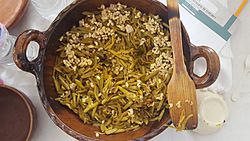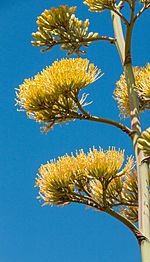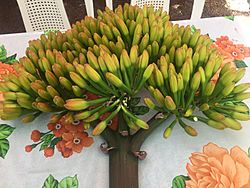Maguey flower facts for kids
The maguey flower (Agave spp.), in Spanish, flor de maguey (Spanish pronunciation: [maˈɣej]), also known locally as gualumbo, hualumbo, quiote or jiote is a typical product of Mexican cuisine, cultivated mainly in the rural areas of the center of the country. Due to its difficult availability, it is considered a delicacy. Maguey flowers are harvested and consumed closed (when they have not yet flowered), since once opened (ripened), they have a bitter taste.
Description
The maguey or agave plant (metl in Nahuatl) is one of the most appreciated quelites in Mexican cuisine. All its parts are used from this plant: the fiber, the sap, the flowers, the stem (quiote) and even the fungi and worms that live in it. There are 159 species of maguey all over Mexico, although the most important are Agave americana, A. atrovirens, A. mapisaga and A. salmiana.
The plant blooms once it reaches its peak ripening stage, between 7 and 15 years of age. The enormous stem sprouts from its center, which can reach up to 10 m. The maguey only blooms once in its entire life. After that, it dies.
The maguey flowers are greenish-yellow, elongated in appearance (~ 10 cm). Each flower has 6 petals and inside, 3 pistils with flattened seeds.
Production
The maguey only blooms once in its life. For this reason, the indigenous peoples of Mexico do not extract all the flowers from them, as an act of respect for the plant that feeds them. To extract the flowers from the maguey, it is not necessary to tear down the stem; a high ladder can be used. In this process, it is important to damage the vegetable as little as possible.
The maguey flower is eaten in the central states of the country, particularly the State of Mexico, Hidalgo, Nayarit, Morelos, Puebla and Tlaxcala. Finding maguey flowers is not an easy task. Although they are generally sold in fresh bunches in local markets, most of the harvested flowers are for self-consumption. They can also be found canned in brine in gourmet stores.
Culinary use

Both the stem and the flower are edible. Due to their bitter taste, it is recommended to "deflam" (desflemar) the flowers (meaning "soften the flavor") by boiling them in salted water. But first, the stems and pistils should be removed, since these would make the stew bitter and are hard to eat. Only the petals are eaten. It is considered a laborious task, requiring some time. The flavor of maguey flowers has been compared to chicken meat, and it is actually considered a substitute for meat.
Gualumbos are a very versatile culinary product. They can be prepared roasted (tatemado), fried with onion and chili, stewed with carnitas, coated in batter (capeado), in papillote (mixiote), filled with white cheese, scrambled with eggs, as a filler for tortitas, bathed in green sauce, or cooked a la mexicana.
In stews, it can be combined with other vegetables (tomato, onion, garlic), meat or longaniza. While cooking, the stew should be covered so that the flowers remain juicy, stirring it every so often. When the flowers change its color to a dark green, they will be ready to be served, and they will give off a unique aroma.
It is traditional to eat maguey flowers during Christian Lent, because it coincides with the flowering stage.
Food for other species
The nectar of the maguey flowers serves as food for migratory bat species. For this reason, it is important not only to collect maguey flowers, but to plant new plants, to avoid endangering the food life cycle of these bats.
See also
 In Spanish: Flor de maguey para niños
In Spanish: Flor de maguey para niños




